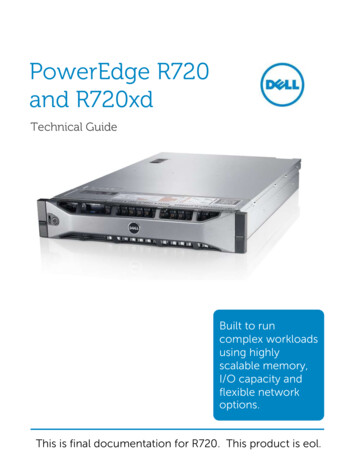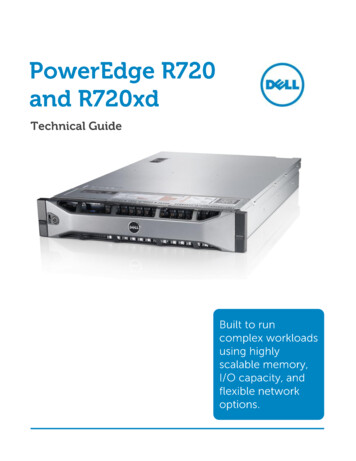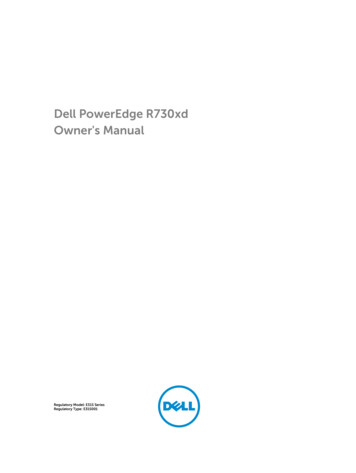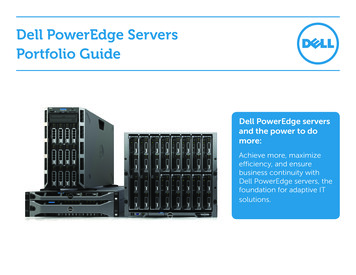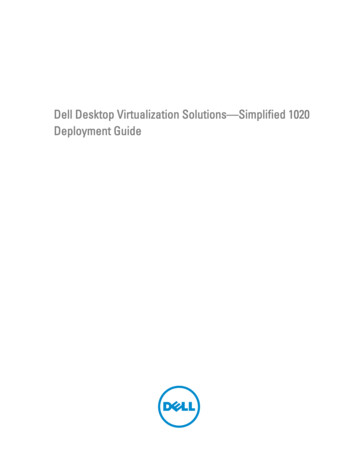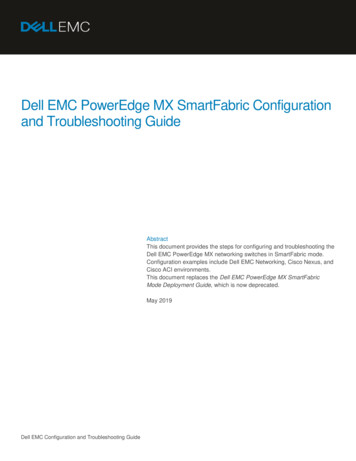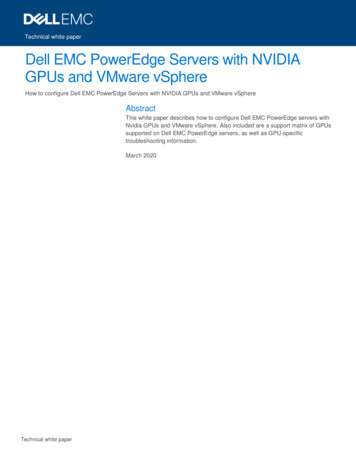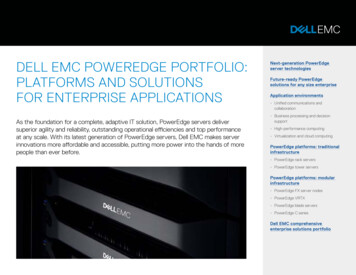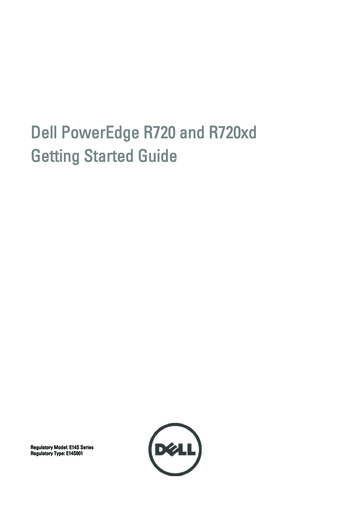
Transcription
Dell PowerEdge R720 and R720xdGetting Started GuideRegulatory Model: E14S SeriesRegulatory Type: E14S001
Notes, Cautions, and WarningsNOTE: A NOTE indicates important information that helps you make better use of yourcomputer.CAUTION: A CAUTION indicates potential damage to hardware or loss of data ifinstructions are not followed.WARNING: A WARNING indicates a potential for property damage, personal injury, ordeath.Information in this publication is subject to change without notice. 2011 Dell Inc. All rights reserved. Printed in the U.S.A.Reproduction of these materials in any manner whatsoever without the written permission of Dell Inc. isstrictly forbidden.Trademarks used in this text: Dell , the Dell logo, Dell Precision , OptiPlex , Latitude , PowerEdge ,PowerVault , PowerConnect , OpenManage , EqualLogic , Compellent , KACE , FlexAddress andVostro are trademarks of Dell Inc. Intel , Pentium , Xeon , Core and Celeron are registeredtrademarks of Intel Corporation in the U.S. and other countries. AMD is a registered trademark andAMD Opteron , AMD Phenom and AMD Sempron are trademarks of Advanced Micro Devices, Inc.Microsoft , Windows , Windows Server , Internet Explorer , MS-DOS and Windows Vista are eithertrademarks or registered trademarks of Microsoft Corporation in the United States and/or other countries.Red Hat and Red Hat Enterprise Linux are registered trademarks of Red Hat, Inc. in the United Statesand/or other countries. Novell and SUSE are registered trademarks of Novell Inc. in the United States andother countries. Oracle is a registered trademark of Oracle Corporation and/or its affiliates. Citrix , Xen ,XenServer and XenMotion are either registered trademarks or trademarks of Citrix Systems, Inc. in theUnited States and/or other countries. VMware , Virtual SMP , vMotion , vCenter and vSphere areregistered trademarks or trademarks of VMware, Inc. in the United States or other countries. IBM is aregistered trademark of International Business Machines Corporation.Other trademarks and trade names may be used in this publication to refer to either the entities claiming themarks and names or their products. Dell Inc. disclaims any proprietary interest in trademarks and tradenames other than its own.2011 — 08Rev. A00
Installation And ConfigurationWARNING: Before performing the following procedure, review the safetyinstructions that came with the system.Unpacking a Rack SystemUnpack your system and identify each item.Assemble the rails and install the system in the rack following the safety instructions andthe rack installation instructions provided with your system.Figure 1. Installing the Rails and System in a Rack3
Connecting The Optional Keyboard, Mouse, AndMonitorFigure 2. Connecting Keyboard, Mouse, and MonitorConnect the keyboard, mouse, and monitor (optional).The connectors on the back of your system have icons indicating which cable to pluginto each connector. Be sure to tighten the screws (if any) on the monitor's cableconnector.Connecting The Power Cable(s)Figure 3. Connecting the Power Cable(s)4
Connect the system’s power cable(s) to the system and, if a monitor is used, connect themonitor’s power cable to the monitor.Securing The Power Cable(s)Figure 4. Securing the Power Cable(s)Bend the system power cable(s), as shown in the illustration, and attach to the cablestrap.Plug the other end of the power cable(s) into a grounded electrical outlet or a separatepower source such as an uninterruptible power supply (UPS) or a power distribution unit(PDU).Turning On The SystemFigure 5. Turning on the System5
Press the power button on the system. The power indicator should light.Installing The Optional BezelFigure 6. Installing the BezelInstall the bezel (optional).Complete The Operating System SetupIf you purchased a preinstalled operating system, see the documentation associatedwith the operating system. To install an operating system for the first time, see theinstallation and configuration documentation for your operating system. Be sure theoperating system is installed before installing hardware or software not purchased withthe system.NOTE: For the latest information on supported operating systems, see dell.com/ossupport.Dell Software License AgreementBefore using your system, read the Dell Software License Agreement that came withyour system. You must consider any media of Dell-installed software as BACKUP copiesof the software installed on your system’s hard drive. If you do not accept the terms ofthe agreement, call the customer assistance telephone number. For customers in theUnited States, call 800-WWW-DELL (800-999-3355). For customers outside the UnitedStates, visit support.dell.com and select your country or region from the top of the page.6
Other Information You May NeedWARNING: See the safety and regulatory information that shipped with yoursystem. Warranty information may be included within this document or as aseparate document. The Owner’s Manual provides information about system features and describeshow to troubleshoot the system and install or replace system components. Thisdocument is available online at support.dell.com/manuals. The rack documentation included with your rack solution describes how toinstall your system into a rack, if required. Any media that ships with your system that provides documentation and tools forconfiguring and managing your system, including those pertaining to theoperating system, system management software, system updates, and systemcomponents that you purchased with your system.NOTE: Always check for updates on support.dell.com/manuals and read theupdates first because they often supersede information in other documents.Obtaining Technical AssistanceIf you do not understand a procedure in this guide or if the system does not perform asexpected, see your Owner’s Manual. Dell offers comprehensive hardware training andcertification. See dell.com/training for more information. This service may not be offeredin all locations.NOM InformationThe following information is provided on the device described in this document incompliance with the requirements of the official Mexican standards (NOM):Importer:Dell Inc. de México, S.A. de C.V.Paseo de la Reforma 2620 -11º PisoCol. Lomas Altas11950 México, D.F.Model number:E14SSupply voltage:100–240 V CA (with 495 W, 750 W, and 1100 W AC powersupply unit) or –(48–60) V de CC (with 1100 W DC powersupply unit)7
Frequency:Current consumption:50 Hz/60 Hz (AC power supply unit)12 A – 6.5 A (X 2) (with 1100 W AC power supply unit)10 A – 5 A (X 2) (with 750 W AC power supply unit)6.5 A – 3 A (X 2) (with 495 W AC power supply unit)32 A (X 2) (with 1100 W DC power supply unit)Technical SpecificationsNOTE: The following specifications are only those required by law to ship with yoursystem. For a complete and current listing of the specifications for your system, goto support.dell.com.NOTE: The following specifications apply to both PowerEdge R720 and PowerEdgeR720xd unless specified.PowerAC Power Supply (per power supply)Wattage495 W, 750 W, or 1100 WHeat dissipation1908 BTU/hr maximum (495 W powersupply)NOTE: Heat dissipation is calculated2891 BTU/hr maximum (750 W powerusing the power supply wattagesupply)rating.4100 BTU/hr maximum (1100 W powersupply)Voltage100–240 V AC, autoranging, 50/60 HzNOTE: This system is also designedto be connected to IT powersystems with a phase to phasevoltage not exceeding 230 V.DC Power Supply (per power supply) (whenavailable)8Wattage1100 WHeat dissipation4416 BTU/hour maximum
PowerNOTE: Heat dissipation is calculatedusing the power supply wattagerating.Voltage–(48–60) V DCBatteryCoin-cell battery3 V CR2032 Lithium coin cellPhysicalHeight87.3 mm (3.44 inch)WidthWith rack latches482.4 mm (18.98 inch)Without rack latches444 mm (17.08 inch)Depth (includes bezel)755.8 mm (29.75 inch)Weight (maximum)2.5-inch hard-drive systems29.5 kg (64.9 lbs)3.5-inch hard-drive systems(PowerEdge R720)29.2 kg (64.3 lbs)3.5-inch hard-drive systems(PowerEdge R720xd)32.5 kg (71.5 lbs)Weight (empty)2.5-inch hard-drive systems11.7 kg (25.7 lbs)3.5-inch hard-drive systems10.3 kg (22.7 lbs)EnvironmentalNOTE: For additional information about environmental measurements for specificsystem configurations, see dell.com/environmental datasheets.TemperatureOperatingContinuous operation: 10 C to 35 C at10% to 80% relative humidity (RH), with 269
Environmental C max dew point. De-rate maximumallowable dry bulb temperature at 1 C/300 m above 900 m (1 F per 550 ft).NOTE: When using PowerEdge R720with internal GPGPU card(s), thecontinuous operation range is 10 C to30 C at 10% to 80% RH, with 26 Cmax dew point.NOTE: For information on supportedexpanded operating temperaturerange and configurations, seesupport.dell.com/manuals.Storage–40 C to 65 C (–40 F to 149 F) with amaximum temperature gradation of 20 Cper hourRelative humidityOperating20% to 80% (noncondensing) at amaximum wet bulb temperature of 29 C(84.2 F)Storage5% to 95% at a maximum wet bulbtemperature of 38 C (100.4 F)Maximum vibrationOperating0.26 Grms at 5–350 Hz (all operationorientations)Storage1.87 Grms at 10–500 Hz for 15 min (all sixsides tested)Maximum shock10OperatingOne shock pulse in the positive z axis(one pulse on each side of the system) of31 G for 2.6 ms in the operationalorientationStorageSix consecutively executed shock pulsesin the positive and negative x, y, and z
Environmentalaxes (one pulse on each side of thesystem) of 71 G for up to 2 msSix consecutively executed shock pulsesin the positive and negative x, y, and zaxes (one pulse on each side of thesystem) of 32 G faired square wave pulsewith velocity change at 270 inches/second (685 centimeters/second)AltitudeOperating–15.2 m to 3048 m (–50 ft to 10,000 ft)NOTE: For altitudes above 2950 ft, themaximum operating temperature isderated 1ºF/550 ft.Storage–15.2 m to 10,668 m (–50 ft to 35,000 ft)Airborne Contaminant LevelClassG1 as defined by ISA-S71.04-198511
Securing The Power Cable(s) Figure 4. Securing the Power Cable(s) Bend the system power cable(s), as shown in the illustration, and attach to the cable strap. Plug the other end of the power cable(s) into a grounded electrical outlet or a separate power source such as an uninterruptible power supply (UPS) or a power distribution unit (PDU).
